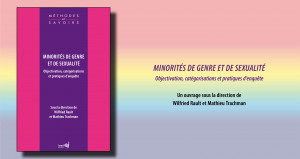Wilfried Rault and Mathieu Trachman

Editors of Minorités de genre et de sexualité, a recent INED Publications release, answered our questions.
(Interview conducted in December 2023)
What is meant by the term “sexual and gender minorities”?
We’ve chosen to use the term sexual and gender minorities, or SGM, rather than LGBT. It’s a term currently used today, and it encompasses not only lesbians, gays, bisexuals, and trans persons but also intersex and asexual persons. It’s an activist tool, an umbrella term that covers groups whose trajectories, ways of living, and political demands are in fact extremely heterogeneous. Obviously that is entirely legitimate, but it shouldn’t keep us from thinking about principles of categorization and grouping, which vary by whether the objective is to constitute a mass of people or to produce a detailed description of particular ways of life, for example. In speaking of minorities, we are emphasizing two characteristics common to all these groups: their low numbers compared to the general population, but first and foremost the fact that they do not align with majority norms, a fact that overexposes them to stigmatization, discrimination, and even violence. So it’s a question of both numbers and social status.
How are sexual and gender minorities identified in surveys?
To identify sexual and gender minorities in a statistical survey, the survey must have indicators to represent them, which is not always the case. The indicators vary by minority group. Questions that allow for identifying people who do not identify in accordance with the binary gender norm are gradually being integrated into questionnaires. An example is the 2022 Canadian census, where for the very first time people were asked “What is your gender?: male/female/other: specify.” The same holds for questions that take into account gender transition. The English and Welsh censuses for 2022 asked “Does the gender you identify as correspond to your sex at birth?: Yes/No: indicate your gender identity.”
Sexual minority indicators were developed some time ago. Classically, three such indicators have been used: identification (reporting being “gay,” “lesbian,” “bisexual,” “pansexual,” for example; attraction (to persons of the same and/or a different gender), and sexual practices. As several chapters of the book demonstrate, these three indicators do not refer to the same experiences of sexuality or the same ways of life. They are also undergoing continual transformation, as attested by the emergence of new categories. For example, people have begun identifying as “pansexual” only recently, and it is not clear whether that self-identification refers to types of attraction and sexual practices distinct from bisexuality or whether we need new indicators to represent its specificities.
So sexual and gender minorities are not always accounted for in surveys?
No. It depends on the survey subject. Surveys on sexuality, violence, and, to a lesser extent, health or the family generally include identifying indicators, but they’re not used as often in surveys on other types of subjects. It is important to include such indicators because it’s a way of recognizing minority experiences and ways of being. But we cannot guarantee that the numbers of SGM respondents will be high enough to include them in statistical processing.
There are other means of studying sexual and gender minorities, or some components thereof, particularly what are called “community” surveys that aim to reach these groups directly. While surveys of this kind usually surrender any attempt to achieve representativeness, they do have the advantage of being designed precisely for sexual and gender minorities. This means the lines of questioning were designed to reach them in their specificity (their degree of (in)visibility, for example, experiences of discrimination, or sexual cultures particular to them). It is important to keep in mind that general population surveys are not neutral: they implicitly give priority to the majority perspective and therefore fail to collect much of minority experience.
What are some current issues in research on sexual and gender minorities?
SGM population groups are changing demographically. An increasing number of women identify as bisexual; more and more people are transitioning to a different gender; new types of self-identification are appearing, such as “pansexual” and “non-binary.” Including these groups by integrating them more effectively into existing survey procedures and developing more reliable indicators—particularly at the public statistics level—is a major issue but it’s not the only one. As we see it, it is important to apprehend how these minorities are evolving. For example, bisexuality had become a widely discredited category, including within sexual minorities, but members of younger generations are now more likely to identify as bisexual. This means that what we need to apprehend are not really fixed or stable population groups waiting for researchers to bring them to light but rather minorities coming into existence, or minority futures, which concern a considerable part of the population because of the way they open up the space of sexual and gender possibility. How to think about and apprehend relations between minorities and majorities is therefore an issue in itself. Two recently conducted surveys are providing us with crucial information for moving research further in this direction: a general population survey on sexual behaviors in France called Contexte de la sexualité en France (INSERM 2023), and Envie, which is studying the sexual and affective trajectories of young people aged 18 to 29 (INED 2023). Findings from these surveys will enable us to acquire better knowledge of sexual and gender minorities and their size, weight, and places within the population at large.
Source: Wilfried Rault et Mathieu Trachman, 2023, Minorités de genre et de sexualité. Aubervilliers : Ined Éditions.
